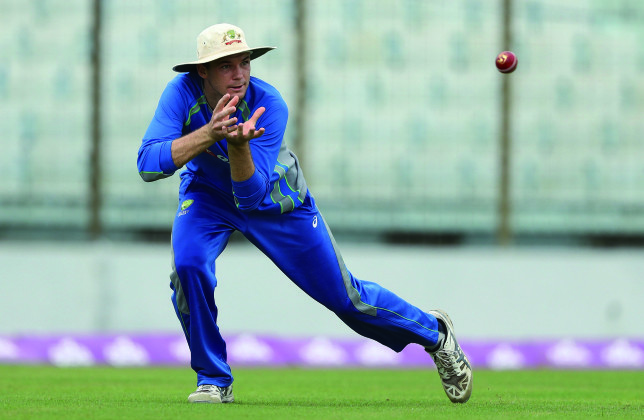
Not every player has a clear-cut role in the team. At least not always.
You have your top order batsmen, wicketkeeper, fast bowlers and frontline spinners. All-rounders play a fluid role, scoring runs and picking up wickets. But all of that happens only when everything falls into place and there are enough players in the squad to do the primary job of scoring runs and picking up wickets consistently.
Sometimes, you get players who offer a bit more than what it says on the cover. And in the eagerness to maximise that bonus, the team misses the bigger picture.
Let’s start with Peter Handscomb. In the Australian camp, Handscomb’s wicketkeeping skills are suddenly in focus. Regular gloveman Matthew Wade is having a horrendous time in the subcontinent, averaging 22 with the bat in eight Tests in Asia.
His twin failures – five and four – in the first Test against Bangladesh have forced the Aussies to think about Handscomb as a wicketkeeper. The Victorian has kept wickets, but mainly in limited overs matches. Keeping in Test matches is a highly specialised job and hardly ever done by ‘part timers’. AB de Villiers kept wickets for South Africa in 24 Tests but the workload proved too much for him. That was an exception that proved the rule.
In all forms of our game the wicket-keeper is a specialist position, I do hope @CricketAus stick with their chosen specialist. #BANvAUS
— Tom Moody (@TomMoodyCricket) September 3, 2017
There are many batsmen who take up the wicketkeeping job in limited overs cricket, but hardly at all in Tests because there is no place to hide in the five-day format. You get five days to ponder over mistakes, which is not great if you are doing a short-term job.
If Handscomb ends up as a Test wicketkeeper and also does a decent job, there is a high probability of it taking his energies away from the primary task.
It’s a fate that befell Irfan Pathan. The Indian left-armer started off as a pace bowler who could bat a bit. But as his career wore on, it emerged Pathan was a quality batsman.
He was tried out as a Test opener against Sri Lanka in 2005, against England in 2006 – both at home – and in Australia in 2008. By that time, his bowling had lost its sting while his batting remained reliable. But the Indian team couldn’t continue with the new-look Pathan, which was its own creation, and Pathan fell out of favour.
Peter Handscomb walked out to train carrying wicketkeeping pads. Rain came moments later. #BANvAUS pic.twitter.com/QlZvsJsPOS
— Adam Collins (@collinsadam) September 2, 2017
And not to forget Kedar Jadhav. The India lower order batsman is in the team as a power hitter. Then Virat Kohli and India discovered his menacingly slow off spin which proved difficult to negotiate and almost always produced a wicket or two. That’s very good but it has taken the focus away from his main role – that of a batsman.
Of late, his batting has veered of track, with his fifty yesterday against Sri Lanka coming after seven attempts. A lack of application with the bat and in the field became too obvious to ignore and he was benched in the fourth ODI.
He was back for the final match but in place of KL Rahul, who only had three ODI failures to his name after a spectacular run in Tests. Which means Jadhav’s awkward off-spin kept out a proper batsman and a good fielder from the XI.
Handling such ‘bonus’ talents can prove to be very tricky. Such stop-gap arrangements almost never turn into long-term solutions. All they end up doing is stop the team management from trying out a ‘proper’ option.
Handscomb should not be burdened with wicketkeeping in Tests. Jadhav should be assessed as a lower order batsman first. But chances are, teams will continue to be enamoured by what ‘else’ they offer and, possibly, unsettle the team balance.
India are the latest team to put clear targets in place as far as fitness is concerned for international players. Those who don’t meet them are simply not welcome.
With the focus of almost all teams on a basic level of fitness, one wonders whether some of the finest players of their era would have fit into the current set-up.
Inzamam ul Haq was famous for his robust physique. The burly Pakistan batsman lost 18kgs ahead of the 2003 World Cup. He scored 19 runs in the entire tournament and decided to never go down that route again. Arjuna Ranatunga and David Boon were other legends who carried extra baggage. Jesse Ryder is another maverick talent who struggled with his weight.
Samit Patel had a stellar finals day at the T20 Blast for Nottinghamshire. The all-rounder revealed the pain of being overlooked by England despite playing some of his best limited overs cricket at the age of 32. His weight is undoubtedly still an issue. It seems the days of Inzys and Boons are well behind us.